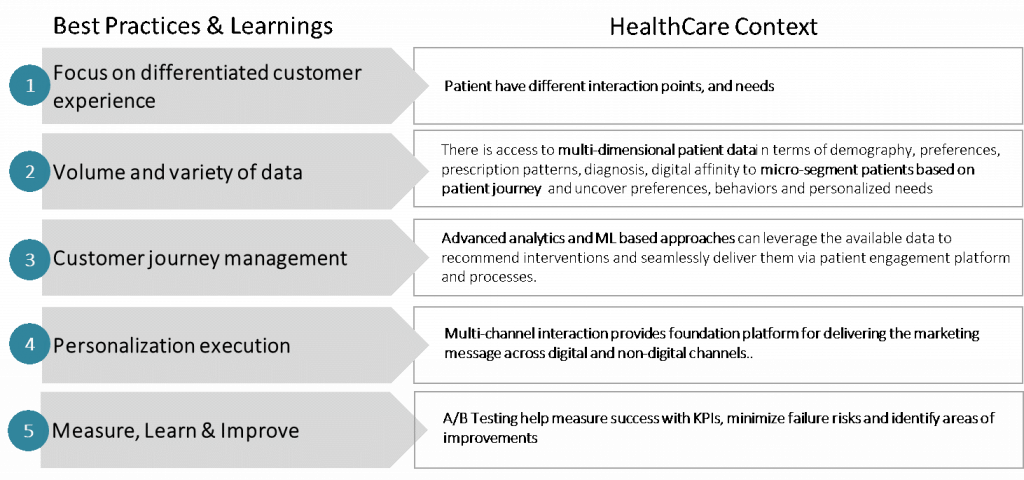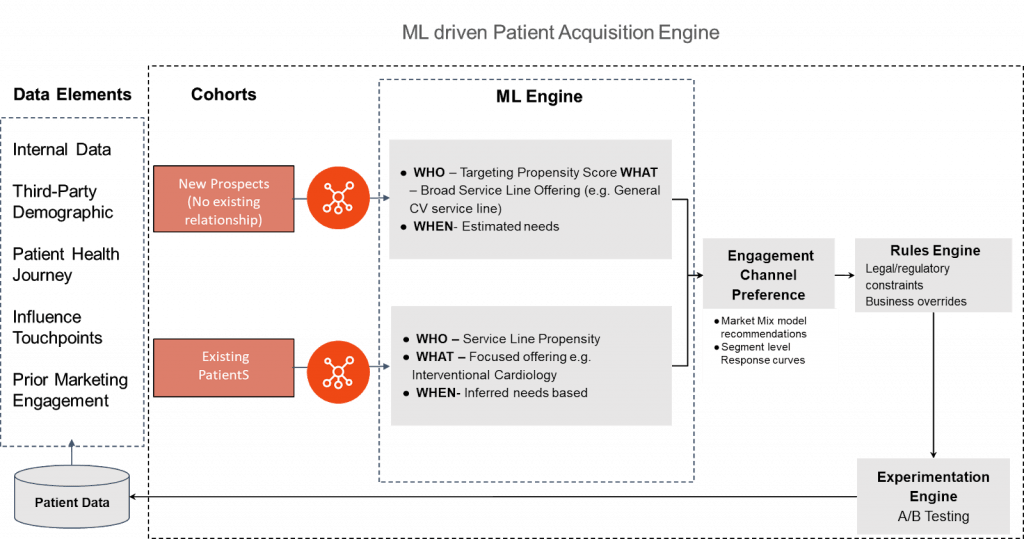Patient Marketing: Changing Landscape
I have seen patient marketing in HealthCare undergo significant change in a rapidly transforming commercial and digital environment. There are numerous factors disrupting the status quo:
- Increasing role of patients in treatment and care
- Competition for “high-value” patients for “elective” provider service lines (e.g. Knee Replacement)
- The availability of large “volume” and “variety” of data, and tools to organize and mine it
- Growing importance of alternate channels (increasingly digital) to reach prospective patients
- A steady increase in HealthCare digital marketing spend; albeit it’s still significantly lower compared to other industries
Personalization: From Consumer Internet to Patient Acquisition Marketing
Traditional patient marketing by HealthCare providers presents a number of challenges:
- It is rules driven broad based targeting and does not mine available data to create a patient 360 profile for personalized outreach
- The importance of patient journey map and the role of “influencers” is not explicitly mapped
- Channel preference is not explicitly modelled or accounted for
- Past campaigns and channel outreach not incorporated
Given the changes in the commercial marketing environment, it is imperative that HealthCare Providers drive personalization in patient targeting – the “right patients” to target with the “right channel outreach” and the “right message”
The native digital firms are at the cutting edge of using advanced AI/ML modelling techniques to drive effective consumer targeting. National retailers’ online loyalty programs are a good example of how these firms leverage data to optimize targeting. They use multi-year history of data (website visits, clicks and conversions along with email opens, clicks and subsequent conversions) in Bayesian machine learning models, to create a propensity score for each product-consumer segment. This is employed for personalized e-marketing and user experience, with estimated marketing ROI improvement of around 20 percentage points.
Some key learnings from these firms include:
- Untargeted outreach is ineffective – users tune them out
- Machine learning models can leverage history of user behaviour on emails, apps, website and offline data such as phone calls or sales contacts
- The models can be operationalized to power personalized experience on all “user touch points”, such as emails, website, call centre etc.
- Personalized experiences leads to user delight and increased response rates, as well as reduce churn and improve ROI of marketing channel promotions.
Bringing Learnings and Best Practices from Digital Native Firms to HealthCare
In order to leveraging the experience from digital native firms, it is imperative that we bring the “Best Practices and Learnings” to the HealthCare business context:


Patient Acquisition Marketing Personalization: Problem-Solving Framework
A structured problem solving approach is necessary to analyse personalization in patient marketing. A key part of this framework is to link the
propensity prediction and recommendation to patient segmentation and available data (patients with some history within our system vs. new prospects).
In addition, the prioritization must be linked to core business objectives e.g. drive business in “orthopaedic surgery line of service as part of overall expansion and profitability strategy”
A broad outline of the problem solving framework and its constituent parts is shown in the illustration below:


In my experience, the key to driving personalization in patient acquisition is:
- Creating a 360 patient profile including the journey map for existing patients
- Choice of “appropriate” ML modelling approach based on patient segment (existing vs. new prospect)
- Channel preference modelling based on available data and/or experimentation approach to try out alternative outreach strategies
- Ability to augment modelling results with business priority driven rules
- Integration of existing patient outreach infrastructure to deliver marketing message via the appropriate channel
Program Execution
There is great diversity across organizations. In order to successfully execute personalized targeting and digital marketing solutions, it is also imperative to define the right operating model that aligns with business objectives, organizational strengths, and the right partner(s).
Here is a brief outline of an execution approach that I have been seen work well:
- The output from the “personalization” analysis is executed thru the existing patient engagement platforms
- It is also imperative to deploy an A/B testing framework to improve our channel outreach and messaging over time
- Finally, a “system of insights” that can track the effectiveness of our marketing efforts and deliver both “insights” and “course-correction” recommendations is key for ongoing success and to optimize program ROI


In conclusion, a data-driven approach that leverages the best in class AI/ML modelling; implemented within the context of our organizational engagement model, and focused on key business metrics is critical to driving successful implementation of patient marketing programs.




